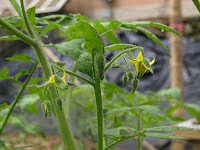In one of my previous posts, I talked about the terrifying
power of nature and how any trees we plant might be ripped up by the river at
any minute. Turns out, I need to think on a slightly smaller scale on a day to
day basis.
Meet my adversaries.....
 |
| Cut worms burrowing into the maize stalks |
 |
| Aphids attacking the kale |
 |
| Leaf cutter ants returning to their nest with a successful harvest |
The cutworms have been plaguing the maize; burrowing down
into the ear, leaving their trail of destruction (rather holey leaves and
yellow gunk) as a handy detection aid. It comes as no surprise that the first
line of organic defence is rather time consuming.... pluck them out with
tweezers one by one! And don’t even consider embarking on this task without
full length trousers, a long sleeve shirt and a hat, or everything else out
there will attempt to eat you alive! The second line of defence is slightly
less pleasant. You put the ‘plucked’ cutworms in the blender, dilute the
product with water and spray it onto the crop. Apparently this spray then contains a chemical called Bacillus thuringiensis (or Bt). When this is eaten by fellow cutworms it
produces a protein that paralyzes their digestive system, causing them to die from starvation. Sounds nasty,
but kind of necessary if we want any maize to harvest!
Aphids are a problem I’m a little more familiar with, but I
have to confess that some of the organic suggestions for getting rid of them such
as frying the aphids by placing tin foil under the affected plants and deterring
them with shredded banana leaves buried underneath, were new to me. I settled
for a more personally tried and tested method- onion, garlic and chilli spray.
I’ll let you know how it works or if I need to up the concentration.
In the way of leaf cutter ants, I spotted them over a week ago now. I
naively hoped that they would continue to prefer their weed diet and only use
my garden as an access route, leaving my plants alone. No such luck. The broccoli
was the fall guy and the ants made easy work of nearly all the broccoli leaves
over the space of two evenings. They’re pretty amazing creatures- able to carry
twenty times their own body weight, building nests that cover up to 600 square metres and house up to 8 million individual ants, and
being able to decimate foliage on an entire tree in a single night. And they don’t even
actually eat the leaves! Instead they take them into their nest where the
leaves act as a compost for their fungus food. Knowing the likely size of
their nest, we decided that boiling water wasn’t a particularly viable option.
So we’re trying out two methods of killing their fungus- blended citrus peels
and boric acid (the second method being a little more aggressive!!), both placed
around their nest holes so that they’ll traipse it into the nest on their feet.
So my fingers are crossed that our
anti-pest measures take effect. Otherwise the beds that we've worked on for 2 months now may start to look very bare! And if anyone reading this knows of any other better, non toxic
methods of pest control then please let me know. I’m clearly still wet behind
the ears about tropical horticulture!

















